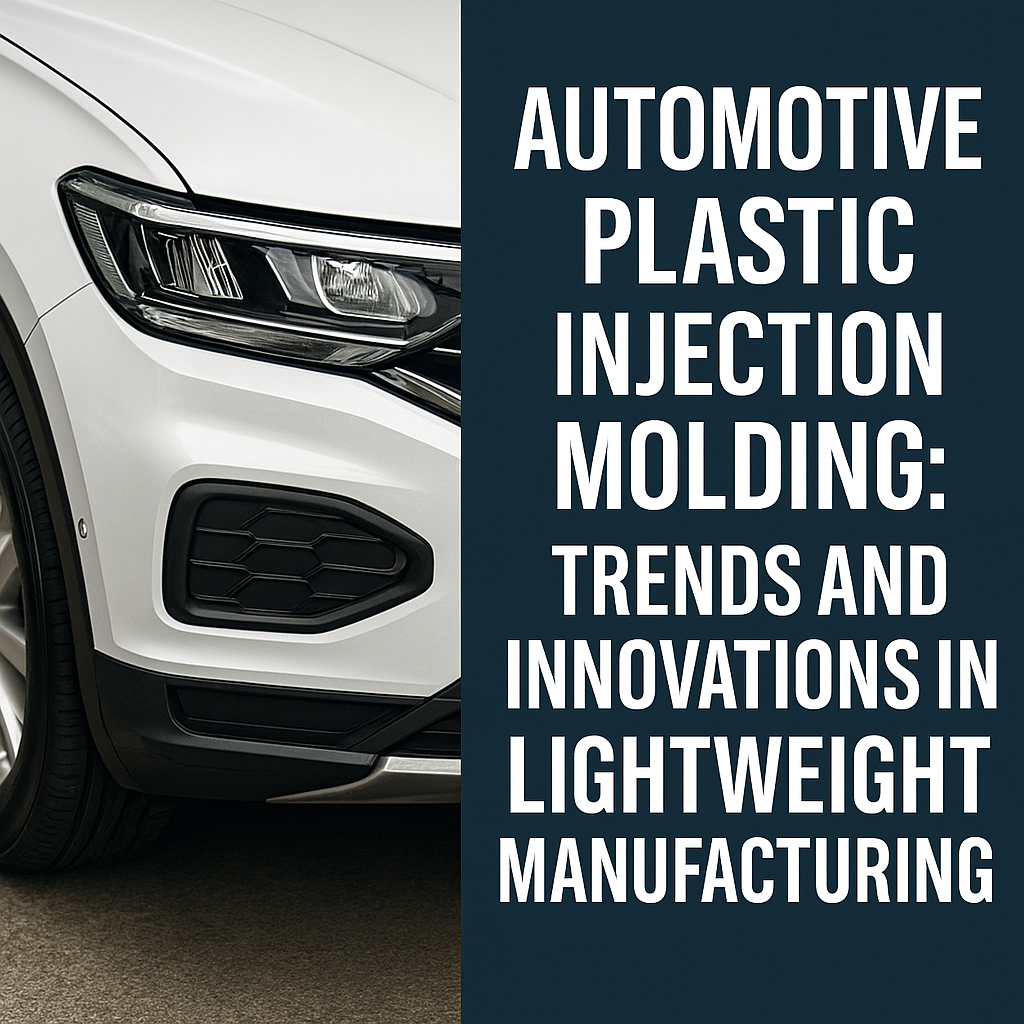Automotive Plastic Injection Molding: Trends and Innovations in Lightweight Manufacturing
Automotive Plastic Injection Molding: Trends and Innovations in Lightweight Manufacturing

Automakers face relentless pressure to improve fuel efficiency, extend electric‑vehicle (EV) range, and meet stringent CO₂ targets—without sacrificing safety or aesthetics. Automotive injection molding has emerged as a cornerstone of this mission, enabling designers to replace heavy metal parts with high‑performance plastics that slash curb weight and unlock new design freedom. This pillar article explores key trends, materials, and process innovations driving the next generation of lightweight plastic manufacturing for interior, exterior, and electronic applications.
1 Why Lightweight Matters in Modern Vehicle Design
| Factor | Impact of Weight Reduction |
|---|---|
| Fuel economy / EV range | Every 10 kg saved can boost mileage by 0.3–0.5 % or extend EV range by 1–2 km. |
| CO₂ emissions | Lighter vehicles emit less CO₂ per kilometre—crucial for EU, US, and China targets. |
| Performance | Improved acceleration, handling, and braking responsiveness. |
| Cost savings | Downsized engines, smaller battery packs, and reduced material shipping weight. |
Plastics such as PP, ABS, PC / ABS, PA 6/6, and reinforced PP or PA compounds now replace steel and aluminum in countless components—often at lower cost and with superior corrosion resistance.
2 Interior Applications: From Dashboards to Displays
-
Instrument Panels & Dashboards
Long‑glass‑fiber PP delivers high stiffness at half the weight of steel sub‑frames. -
Door Panels & Trim
Foamed PP cores with thin‑wall skins reduce mass and improve energy absorption. -
Center Consoles & Speaker Grilles
PC / ABS blends offer Class A surface quality ready for soft‑touch paint or in‑mold grain textures. -
HVAC Ducting
Thin‑wall PP tubes replace stamped steel, slashing noise‑vibration‑harshness (NVH).
Innovation spotlight: Insert‑molded illuminated icons combine clear PMMA light pipes with textured PC/ABS housings—molded in a single shot for seamless cockpit UX.
3 Exterior Components: Bumpers, Grilles, and Beyond
-
Bumper Fascias & Energy Absorbers
TPO and PP‑EPDM blends provide impact resistance in temperatures from −30 °C to 80 °C. -
Active Grille Shutters
Glass‑filled PPA withstands under‑hood heat while reducing aerodynamic drag. -
Wheel Arch Liners & Under‑Body Shields
Recycled PP compounds cut weight and promote circular‑economy content targets.
Two‑shot overmolding enables integrated seals and soft touch zones—eliminating secondary assembly of rubber parts.
4 Electronics & e‑Powertrain Components
| Component | Plastic Solution | Benefit |
|---|---|---|
| Battery pack covers (EV) | Flame‑retardant PC / ABS | UL 94 V‑0, weight ↓ 30 % vs. aluminum |
| ADAS sensor housings | Glass‑filled PBT | Dimensional stability + EMI shielding coatings |
| High‑current busbar supports | PA 6/6 + GF | High dielectric strength and mechanical rigidity |
Advanced in‑mold electronics (IME) embed flexible circuits and antennas into decorative surfaces—reducing wiring harness mass.
5 Process Innovations Driving Lightweight Plastic Manufacturing
-
Foam Injection Molding (MuCell® / chemical foaming)
Creates microcellular cores that cut part weight by 10–20 % while maintaining outer‑skin quality. -
Gas‑Assist & Water‑Assist Molding
Hollow sections for grab‑handles, seat frames, and structural ducts. -
Conformal‑Cooled Molds
3‑D printed channels reduce cycle time and warpage in large bumper tools. -
In‑Mold Decoration & IMD/FIM
Applies films or graphics during molding—no added paint weight.
6 Material Advancements
-
Short & Long‑Glass‑Fiber Reinforced PP – up to 50 % weight savings vs. steel, with comparable modulus.
-
Carbon‑Fiber PA‑6 – ultra‑light structural brackets for sports cars.
-
Recycled‑content PP (PCR) – meets OEM sustainability KPIs without sacrificing mechanicals.
7 Partnering with INTERTECH for Automotive Injection Molding
As a Taiwan‑based Tier‑2 supplier, INTERTECH offers:
-
IATF 16949 quality management
-
Presses 50 t–650 t including two‑shot rotary
-
In‑house mold design with CAE flow & warpage simulation
-
Experience with glass‑fiber PP, PC / ABS, PBT, TPO, and carbon‑fiber PA
-
JIT and sequenced delivery for global OEM programs
View our automotive case studies or contact us for a DFM review.
Conclusion
The shift toward lightweight plastic manufacturing is reshaping the automotive sector. By leveraging advanced automotive injection molding processes, innovative materials, and design‑for‑lightweight strategies, manufacturers can achieve fuel‑efficiency gains, reduce CO₂ emissions, and deliver cutting‑edge user experiences.
Ready to replace metal with high‑performance plastic auto parts? Contact INTERTECH to explore custom solutions.

Explore Our Key Services at Taiwan Mold Maker:
-
✔️ Custom Mold and Design Maker — Tailored mold design and engineering support for unique product requirements.
-
✔️ Mold Service — Full-process mold development from DFM to tooling and validation.
-
✔️ Injection Mold — High-precision plastic injection molds for mass production.
-
✔️ Silicone Mold — Flexible, heat-resistant silicone molds for consumer and industrial use.
-
✔️ Liquid Silicone Rubber Mold — Ideal for healthcare, baby products, and precision soft-touch applications.
-
✔️ Metal Stamping — Integrated sheet metal solutions for hybrid plastic-metal components.
-
✔️ Molding — Reliable molding services for short-run or mass production of plastic parts.
-
✔️ Customer Examples — Real case studies from global clients in automotive, electronics, medical, and more.







